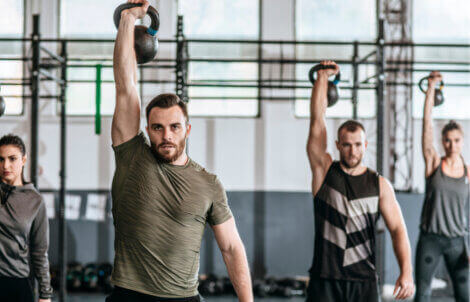Types of Exercise that Burn the Most Calories

Exercising is the best way to burn calories. However, not all activities burn the same amount of calories. It’s therefore essential to quantify your daily energy needs and plan a diet and a workout routine accordingly, always having in mind which types of exercise burn the most calories.
To be in good health and achieve athletic-level performance, caloric intake must go hand in hand with caloric output, except in special situations. In this article, you’ll learn how many calories you can burn depending on the types of exercise that you do, which will help you to properly calculate caloric intake.
Multi-joint exercises to burn calories
One thing that influences the energy expenditure of a certain activity is the number of muscles that you’re working while doing it. The more muscles you use, the higher the body’s caloric demands.
Thus, and according to a research study published in the journal, Applied Physiology, Nutrition, and Metabolism a workout that involves many muscles, such as CrossFit, generates a caloric output of about 200 calories per 10-minute session.
Olympic weightlifting is great at increasing the caloric output of a training session. Also, including squats or deadlifts in your routine helps increase energy expenditure. However, since these exercises have a certain technical complexity, you should do them under the supervision of a qualified professional.

Burning calories with intense physical activity
When the goal is to increase energy expenditure, it’s essential to choose a high-intensity physical activity. In fact, you’ll be able to burn more calories in a training session than in an aerobic routine.
According to a study published in the Obesity Reviews journal, high-intensity interval training stimulates weight loss more efficiently than moderate-intensity exercise.
Likewise, sports that focus on strength increase caloric expenditure once the training session is over. In addition, these generate muscle hypertrophy.
Having more muscle tissue, which is highly active metabolically speaking, increases caloric output and even basal metabolic rate. That’s why it’s often recommended to first grow muscle mass if one wants to lose weight faster in the future.
Aerobic workouts burn the fewest calories
Compared to strength exercises, aerobic workouts require lower energy demands. However, such demands are often sustained over time, so the low intensity is compensated by the ability to perform physical activity for longer periods of time.
If you have little time, the best thing to do to burn more calories is strength exercises. However, if you have time to spare, you can also consider a low-intensity, long-duration training program to achieve a similar effect. But remember that longer workouts can lead to loss of lean tissue, which translates into less muscle mass.

In any case, the really important thing when choosing an exercise isn’t the number of calories you burn while doing it, but how comfortable you feel doing it. Find an activity that’s fun for you, in order to avoid throwing in the towel.
Not all exercises burn the same number of calories
Energy demand depends on the type of exercise you do. While high-intensity and multi-joint workouts significantly increase caloric expenditure, aerobic or endurance exercises are less influential in this regard.
If your goal is to lose weight, we recommend that you choose multi-joint exercises that involve many muscle groups. You should do them at a high or moderate intensity for the best results. And remember that in case you want to do aerobic workouts, you’ll have to spend longer doing them to burn more calories.
Finally, it’s worth emphasizing the importance of exercising correctly, under the supervision of a professional. This way, you’ll reduce the risk of injury and you’ll be healthier in the long run. Also, start eating healthier to maximize results.
Exercising is the best way to burn calories. However, not all activities burn the same amount of calories. It’s therefore essential to quantify your daily energy needs and plan a diet and a workout routine accordingly, always having in mind which types of exercise burn the most calories.
To be in good health and achieve athletic-level performance, caloric intake must go hand in hand with caloric output, except in special situations. In this article, you’ll learn how many calories you can burn depending on the types of exercise that you do, which will help you to properly calculate caloric intake.
Multi-joint exercises to burn calories
One thing that influences the energy expenditure of a certain activity is the number of muscles that you’re working while doing it. The more muscles you use, the higher the body’s caloric demands.
Thus, and according to a research study published in the journal, Applied Physiology, Nutrition, and Metabolism a workout that involves many muscles, such as CrossFit, generates a caloric output of about 200 calories per 10-minute session.
Olympic weightlifting is great at increasing the caloric output of a training session. Also, including squats or deadlifts in your routine helps increase energy expenditure. However, since these exercises have a certain technical complexity, you should do them under the supervision of a qualified professional.

Burning calories with intense physical activity
When the goal is to increase energy expenditure, it’s essential to choose a high-intensity physical activity. In fact, you’ll be able to burn more calories in a training session than in an aerobic routine.
According to a study published in the Obesity Reviews journal, high-intensity interval training stimulates weight loss more efficiently than moderate-intensity exercise.
Likewise, sports that focus on strength increase caloric expenditure once the training session is over. In addition, these generate muscle hypertrophy.
Having more muscle tissue, which is highly active metabolically speaking, increases caloric output and even basal metabolic rate. That’s why it’s often recommended to first grow muscle mass if one wants to lose weight faster in the future.
Aerobic workouts burn the fewest calories
Compared to strength exercises, aerobic workouts require lower energy demands. However, such demands are often sustained over time, so the low intensity is compensated by the ability to perform physical activity for longer periods of time.
If you have little time, the best thing to do to burn more calories is strength exercises. However, if you have time to spare, you can also consider a low-intensity, long-duration training program to achieve a similar effect. But remember that longer workouts can lead to loss of lean tissue, which translates into less muscle mass.

In any case, the really important thing when choosing an exercise isn’t the number of calories you burn while doing it, but how comfortable you feel doing it. Find an activity that’s fun for you, in order to avoid throwing in the towel.
Not all exercises burn the same number of calories
Energy demand depends on the type of exercise you do. While high-intensity and multi-joint workouts significantly increase caloric expenditure, aerobic or endurance exercises are less influential in this regard.
If your goal is to lose weight, we recommend that you choose multi-joint exercises that involve many muscle groups. You should do them at a high or moderate intensity for the best results. And remember that in case you want to do aerobic workouts, you’ll have to spend longer doing them to burn more calories.
Finally, it’s worth emphasizing the importance of exercising correctly, under the supervision of a professional. This way, you’ll reduce the risk of injury and you’ll be healthier in the long run. Also, start eating healthier to maximize results.
All cited sources were thoroughly reviewed by our team to ensure their quality, reliability, currency, and validity. The bibliography of this article was considered reliable and of academic or scientific accuracy.
- Schubert MM., Palumbo EA., Energy balance dynamics during short term high intensity functional training. Appl Physiol Nutr Metab, 2019. 44 (2): 172-178.
- Wewege M., Den Berg R., Ward RE., Keech A., The effects of high intensity Interval training vs moderate intensity continuous training on body composition in overwight and obese adults: a systematic review and meta analysis. Obes Rev, 2017. 18 (6): 635-646.
This text is provided for informational purposes only and does not replace consultation with a professional. If in doubt, consult your specialist.








